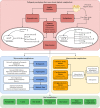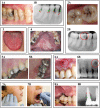Evaluating All Potential Oral Complications of Diabetes Mellitus
- PMID: 30962800
- PMCID: PMC6439528
- DOI: 10.3389/fendo.2019.00056
Evaluating All Potential Oral Complications of Diabetes Mellitus
Abstract
Diabetes mellitus (DM) is associated with several microvascular and macrovascular complications, such as retinopathy, nephropathy, neuropathy, and cardiovascular diseases. The pathogenesis of these complications is complex, and involves metabolic and hemodynamic disturbances, including hyperglycemia, insulin resistance, dyslipidemia, hypertension, and immune dysfunction. These disturbances initiate several damaging processes, such as increased reactive oxygen species (ROS) production, inflammation, and ischemia. These processes mainly exert their damaging effect on endothelial and nerve cells, hence the susceptibility of densely vascularized and innervated sites, such as the eyes, kidneys, and nerves. Since the oral cavity is also highly vascularized and innervated, oral complications can be expected as well. The relationship between DM and oral diseases has received considerable attention in the past few decades. However, most studies only focus on periodontitis, and still approach DM from the limited perspective of elevated blood glucose levels only. In this review, we will assess other potential oral complications as well, including: dental caries, dry mouth, oral mucosal lesions, oral cancer, taste disturbances, temporomandibular disorders, burning mouth syndrome, apical periodontitis, and peri-implant diseases. Each oral complication will be briefly introduced, followed by an assessment of the literature studying epidemiological associations with DM. We will also elaborate on pathogenic mechanisms that might explain associations between DM and oral complications. To do so, we aim to expand our perspective of DM by not only considering elevated blood glucose levels, but also including literature about the other important pathogenic mechanisms, such as insulin resistance, dyslipidemia, hypertension, and immune dysfunction.
Keywords: diabetes mellitus; dyslipidemia; hyperglycemia; hypertension; immune dysfunction; insulin resistance; oral complications.
Figures


Similar articles
-
Oral manifestations in type-2 diabetes and related complications.Indian J Endocrinol Metab. 2012 Sep;16(5):777-9. doi: 10.4103/2230-8210.100673. Indian J Endocrinol Metab. 2012. PMID: 23087863 Free PMC article.
-
Interplay Among the Oral Microbiome, Oral Cavity Conditions, the Host Immune Response, Diabetes Mellitus, and Its Associated-Risk Factors-An Overview.Front Oral Health. 2021 Sep 9;2:697428. doi: 10.3389/froh.2021.697428. eCollection 2021. Front Oral Health. 2021. PMID: 35048037 Free PMC article. Review.
-
Chronic hyperglycemia and glucose toxicity: pathology and clinical sequelae.Postgrad Med. 2012 Nov;124(6):90-7. doi: 10.3810/pgm.2012.11.2615. Postgrad Med. 2012. PMID: 23322142 Review.
-
Is there a relationship between oral health and diabetic neuropathy?Curr Diab Rep. 2015 Nov;15(11):93. doi: 10.1007/s11892-015-0673-7. Curr Diab Rep. 2015. PMID: 26374570 Review.
-
Path of translational discovery of urological complications of obesity and diabetes.Am J Physiol Renal Physiol. 2017 May 1;312(5):F887-F896. doi: 10.1152/ajprenal.00489.2016. Epub 2017 Jan 4. Am J Physiol Renal Physiol. 2017. PMID: 28052873 Free PMC article. Review.
Cited by
-
Metformin and risk of gingival/periodontal diseases in diabetes patients: A retrospective cohort study.Front Endocrinol (Lausanne). 2022 Oct 5;13:1036885. doi: 10.3389/fendo.2022.1036885. eCollection 2022. Front Endocrinol (Lausanne). 2022. PMID: 36277720 Free PMC article.
-
The role of social networks in diabetes self-care: A cross-sectional study.Health Sci Rep. 2022 Apr 26;5(3):e601. doi: 10.1002/hsr2.601. eCollection 2022 May. Health Sci Rep. 2022. PMID: 35509403 Free PMC article.
-
Cytomorphometric Assessment of Buccal Mucosa Cells and Blood Sugar Status in Diabetic Patients in Zahedan (2019).Med J Islam Repub Iran. 2021 Dec 18;35:168. doi: 10.47176/mjiri.35.168. eCollection 2021. Med J Islam Repub Iran. 2021. PMID: 36686318 Free PMC article.
-
Potency of Hyperbaric Oxygen Therapy on Oral Candidiasis Diabetes Mellitus.Eur J Dent. 2024 Oct;18(4):1062-1068. doi: 10.1055/s-0044-1779425. Epub 2024 Mar 31. Eur J Dent. 2024. PMID: 38555645 Free PMC article.
-
Management of Patients With Glucocorticoid-Related Diseases and COVID-19.Front Endocrinol (Lausanne). 2021 Sep 14;12:705214. doi: 10.3389/fendo.2021.705214. eCollection 2021. Front Endocrinol (Lausanne). 2021. PMID: 34594302 Free PMC article. Review.
References
-
- World Health Organization Global Status Report on Noncommunicable Diseases 2014: Attaining the Nine Global Noncommunicable Diseases Targets; A Shared Responsability. (2014).
-
- Global Health Estimates 2015 : Deaths by Cause Age Sex by Country and by Region 2000-2015. [Internet]. (2016). Available online at: http://www.who.int/entity/healthinfo/global_burden_disease/GHE2015_Death....
-
- Global Report on Diabetes [Internet]. World Health Organization (2016). Available online at: http://www.who.int/diabetes/global-report/en/.
-
- Fowler MJ. Microvascular and macrovascular complications of diabetes. Clin Diabetes (2008) 26:77–82. 10.2337/diaclin.26.2.77 - DOI
Publication types
LinkOut - more resources
Full Text Sources
Miscellaneous

